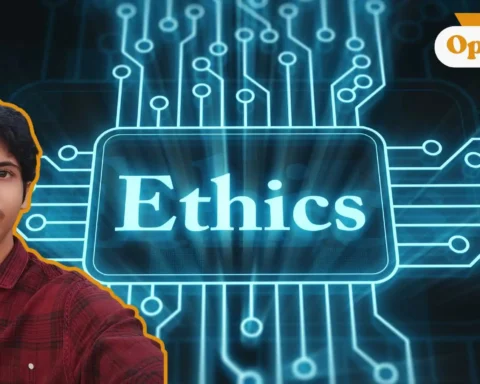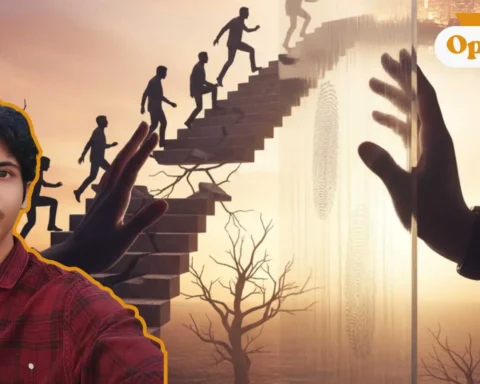The electromagnetic spectrum is a range, a continuous series of related forms of energy. In a similar way, social categorizations also form a spectrum. Within this, gender occupies only a small portion, traditionally perceived as having two binaries placed at opposite ends. The traditional black and white. But the question is, ‘Why is the presence of grey so often questioned? Is grey simply a “third” gender, or can it exist in countless shades, each one a truth of its own?’ The spectrum of identity doesn’t stop at two ends or even at one middle. It stretches into infinite gradations, each as valid and real as the colors we’ve always known.
Then arises the question of gender and media, the persistent issue of misrepresentation, or rather the problem of representation itself, which remains a core challenge. For example, the other day, my college staged a play on women’s empowerment, or Nari Shakti, as we call it. Titled “Draupadi se Draupadi tak”, the performance explored the mythological figure of Draupadi, daughter of King Drupada, the ruler of Panchala, and wife to the five Pandavas in the Mahabharata.
The play unfolds with Yudhishthira, the eldest Pandava, losing Draupadi in the dice game. Summoned to the assembly by Duryodhana, she faces humiliation as Dushasana attempts to disrobe her. When the elders remain silent, Draupadi turns to divine protection, and Lord Krishna intervenes, saving her with an endless stream of cloth.

I have a deep problem with the way women are idealized, placed on pedestals, worshipped as goddesses, yet denied real agency. At the heart of this lies a dangerous expectation: that a woman’s worth is measured by her capacity to sacrifice. If she sacrifices, it is reduced to her duty; if she refuses, she is condemned as selfish or even branded a homebreaker. Such glorification of sacrifice is not empowerment. Instead, it masks oppression, forcing women into silence while romanticizing their suffering.
In the example of the play “Draupadi se Draupadi tak”, I deeply resent the way Draupadi’s humiliation is retold. Why are women, whether Draupadi, our mothers, or our sisters, always expected to sacrifice for their male counterparts? How is it empowerment when Draupadi was dragged into the court and disrobed? Was it empowerment when her husbands watched in silence, powerless and complicit? Or when she cried before the elders, begging them to intervene, only to be met with silence?
For me, empowerment cannot mean celebrating endurance of pain or glorifying helplessness. True empowerment lies in questioning the structures that allow such humiliation to exist in the first place. Until we move beyond idealization and pedestalizing, and instead give women real agency, “Nari Shakti” will remain an unfulfilled promise.
However, unlike the electromagnetic spectrum, which flows linearly based on frequency, social categorizations do not follow a single axis. Instead, they resemble a Venn diagram, where overlapping spaces capture the lived realities of intersection, identities and experiences that blend rather than exist in isolation. These intersections are shaped by caste, creed, gender, race, age, and more. And it is within these shared spaces that the truth of discrimination becomes visible. To me, this is what intersectionality means: understanding oppression as layered, complex, and inseparable from identity.
Another way to understand this is through the concept of layering. It is like a stack of crêpes; the more the layers, the more difficult it becomes to hold together. Similarly, when the aforementioned identities overlap, the weight of discrimination intensifies. Each additional layer does not exist separately but compounds the challenges faced by an individual.
When I look at Draupadi’s story through this lens, I realize her humiliation was not just about gender. It was about power, caste, family honor, and the silence of institutions that chose not to protect her. Similarly, in our own lives, women experience oppression not only because they are women but also because of their class, caste, religion, sexuality, or profession. The burden of sacrifice, silence, and expectation does not fall equally on all women; it weighs heavily on some than on others.
Empowerment, then, cannot be a one-size-fits-all idea. To pedestalize women as goddesses while ignoring the intersections of their lived realities is to repeat the mistake of Draupadi’s courtroom: to watch, to glorify, but not to act. Thus, choosing Draupadi’s story as an example and labeling it as empowerment does not necessarily make it so. This, in fact, is the very issue of representation.

Let us know your thoughts. If you have burning thoughts or opinions to express, please feel free to reach out to us at larra@globalindiannetwork.com.









